Design and Experiment Using Flexible Bumps for Piezoelectric-Driven Hydraulically Amplified Braille Dot Display
Abstract
1. Introduction
2. Structural Composition and Working Principle
2.1. Material and Structure Composition
2.2. Working Principle
3. Analysis and Testing of Amplifying Unit
3.1. Theoretical Analysis
3.2. Output Displacement Test
4. Testing and Analysis
4.1. Instruments and Parameters
4.2. Influence of Driving Voltage on Output Displacement of Flexible Film
4.3. Influence of Driving Frequency on Output Displacement of Flexible Film
4.4. Influence of Fluid Cavity Diameter on Output Displacement of Flexible Film
4.5. Influence of Fluid Cavity Height on Output Displacement of Flexible Film
5. Conclusions
Author Contributions
Funding
Data Availability Statement
Conflicts of Interest
References
- Yeh, F.H.; Tsay, H.S.; Liang, S.H. Human Computer Interface and Optimized Electro-mechanical Design for Chinese Braille Display. Mech. Mach. Theory 2008, 43, 1495–1518. [Google Scholar] [CrossRef]
- Ao, F.X.; Gao, J.F.; Yang, W.Z. Hardware Circuit Design and Realization for Electromagnetic Refreshable Braille Display. Group Technol. Prod. Mod. 2018, 35, 28–33. [Google Scholar]
- Wu, X.L.; Zhu, P.F.; Yang, W.Z. Layered Electro-magnetic Refreshable Braille Display with Haptic Rendering. J. Syst. Simul. 2016, 28, 2220–2226. [Google Scholar]
- Yang, W.Z.; Xu, Y.; Wu, X.L. Research Progress of Braille Display Device. J. Zhejiang Univ. Sci. Technol. 2015, 33, 660–668. [Google Scholar]
- Zhao, F.; Fukuyama, K.; Sawada, H. Compact Braille display using SMA wire array. In Proceedings of the RO-MAN 2009–The 18th IEEE International Symposium on Robot and Human Interactive Communication, Toyama, Japan, 27 September–2 October 2009; ISBN 978-1-4244-5081-7. [Google Scholar]
- Haga, Y.; Makishi, W.; Iwami, K. Dynam Braille display using SMA coil actuator and magnetic latch. Sens. Actuators A Phys. 2005, 119, 316–322. [Google Scholar] [CrossRef]
- Jiang, X.Y.; Hu, Z.J. Design and implementation of braille display based on electrode stimulation principle. Comput. Appl. 2014, 34, 334–337. [Google Scholar]
- Zhang, Z.M.; Liu, J.; Zhao, Y. Design and Implementation of Tactile Vision Substitution System Based on the Fingertips. Chin. J. Med. Phys. 2009, 4, 1293–1298. [Google Scholar]
- Levard, T.; Diglio, P.J.; Lu, S.G. Core-free rolled actuators for Braille displays using P(VDF-TrFE-CFE). Smart Mater. Struct. 2011, 21, 12001–12007. [Google Scholar] [CrossRef] [PubMed]
- Ren, K.; Liu, S.; Lin, M. A compact electroactive polymer actuator suitable for refreshable Braille display. Sens. Actuators A Phys. 2008, 143, 335–342. [Google Scholar] [CrossRef]
- Gabriele, F.; James, B.; Federico, C. Enabling portable multiple-line refreshable Braille displays with electroactive elastomers. Med. Eng. Phys. 2018, 60, 86–93. [Google Scholar]
- Chakraborti, P.; Hak, T.; Yang, P. A compact dielectric elastomer tubular actuator for refresh able Braille displays. Sens. Actuators A Phys. 2012, 179, 151–157. [Google Scholar] [CrossRef]
- Runyan, N.H.; Carpi, F. Seeking the‘holy Braille’ display: Might electromechanically active polymers be the solution. Expert Rev. Med. Devices 2011, 8, 529. [Google Scholar] [CrossRef] [PubMed]
- Thomas, A.; Rufus, E. Alternate braille display designs: A review. Technol. Disabil. 2017, 28, 123–132. [Google Scholar] [CrossRef]
- Williams, T.T.; Robert, M. Interactive braille output for blind computer users. Behav. Res. Methods Instrum. Comput. 1985, 17, 265–267. [Google Scholar] [CrossRef][Green Version]
- Cho, H.C.; Kim, B.S.; Park, J.J. Development of a Braille display using piezoelectric linear motors. In Proceedings of the 2006 SICE-ICASE International Joint Conference, SICE-ICASE, Busan, Korea, 18–21 October 2006; pp. 1917–1921. [Google Scholar]
- Arouette, X.; Matsumoto, Y.; Ninomiya, T. Dynamic Characteristics of a Hydraulic Amplification Mechanism for Large Displacement Actuators Systems. Sensors 2010, 10, 2946–2956. [Google Scholar] [CrossRef] [PubMed]
- Yang, X.; Jia, Z.; Guo, D.; Wang, X. Study on Giant Magnetostrictive Actuator Based on Disk-Shape Diaphragm Compliant Structure. China Mech. Eng. 2002, 13, 474–477. [Google Scholar]
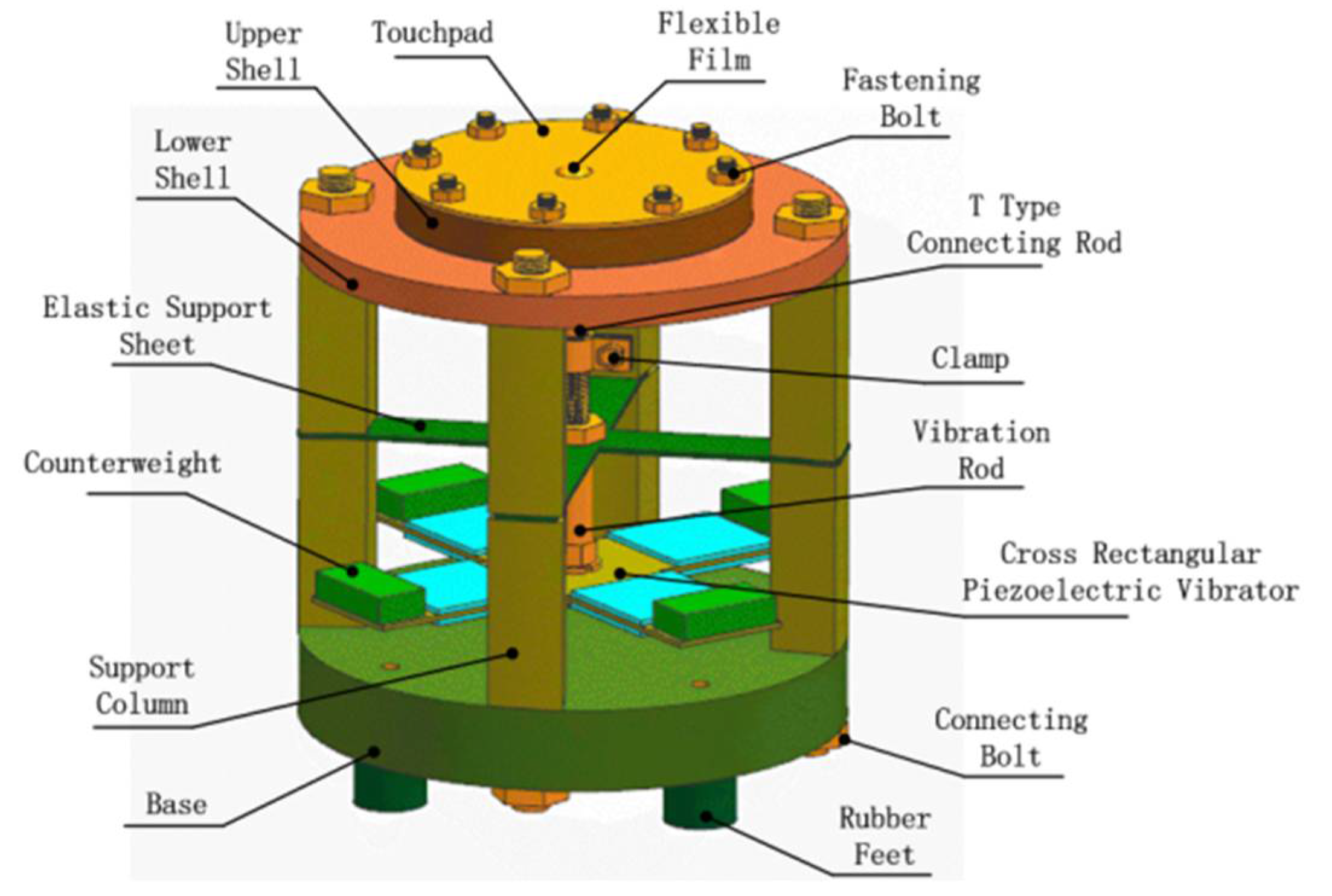
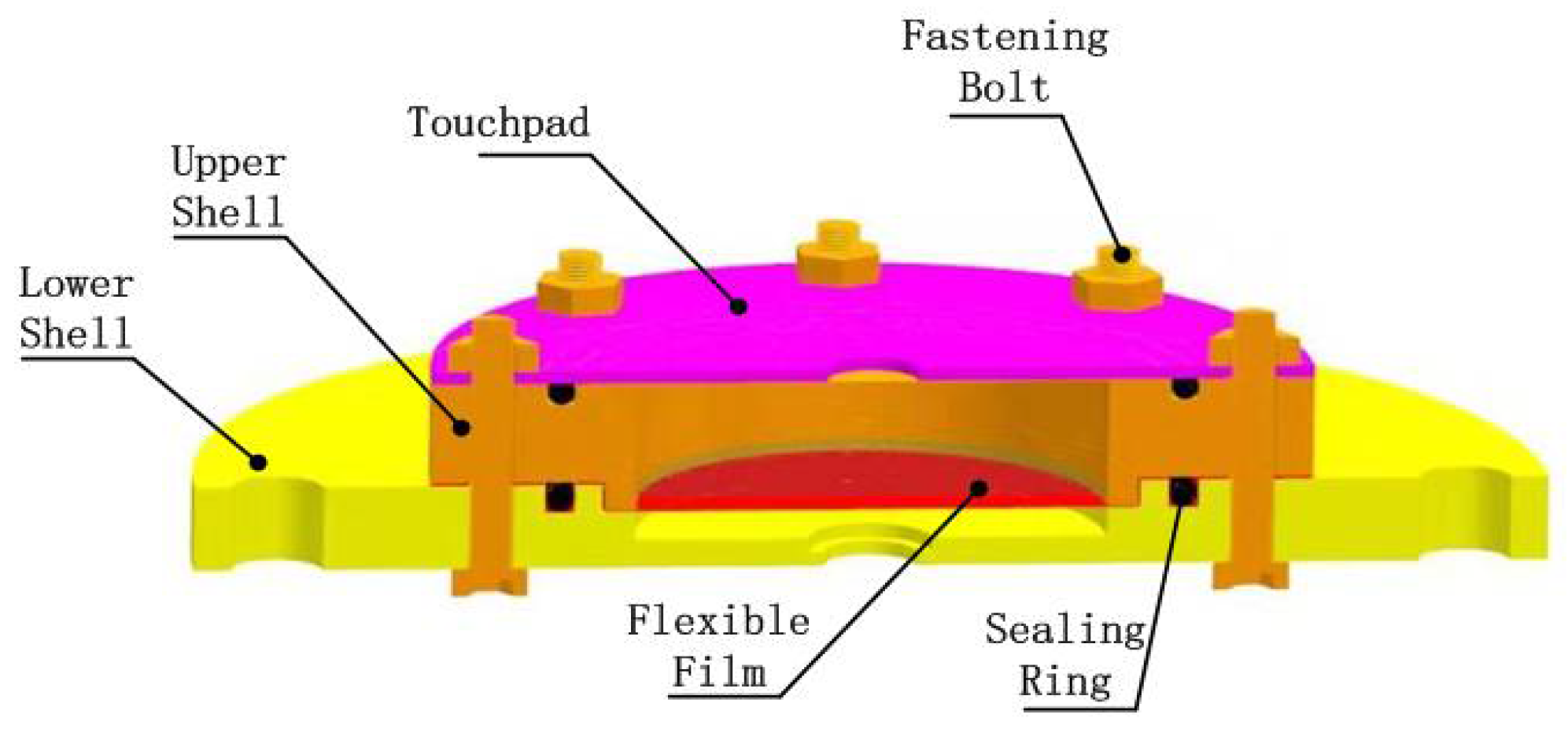


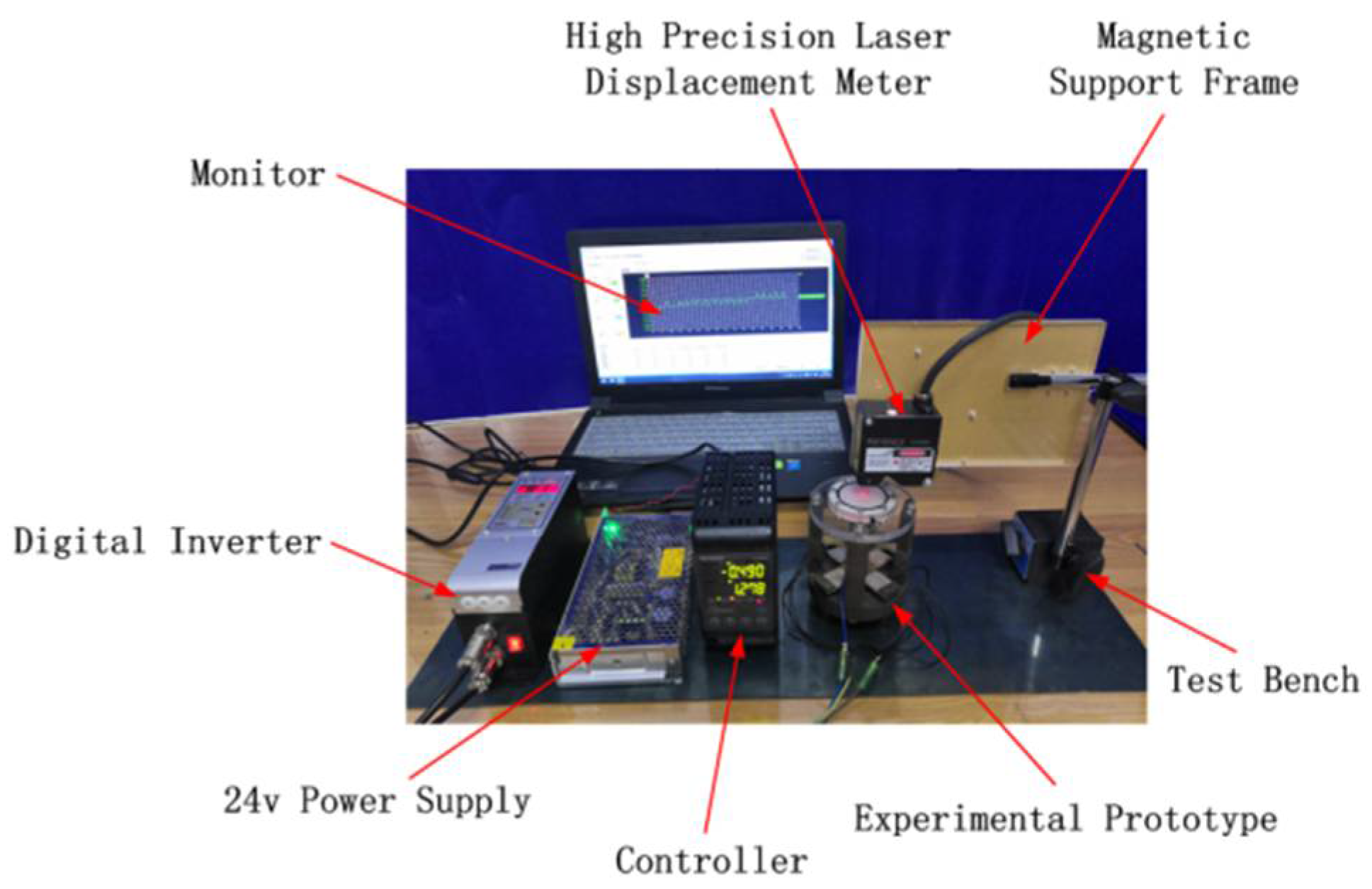
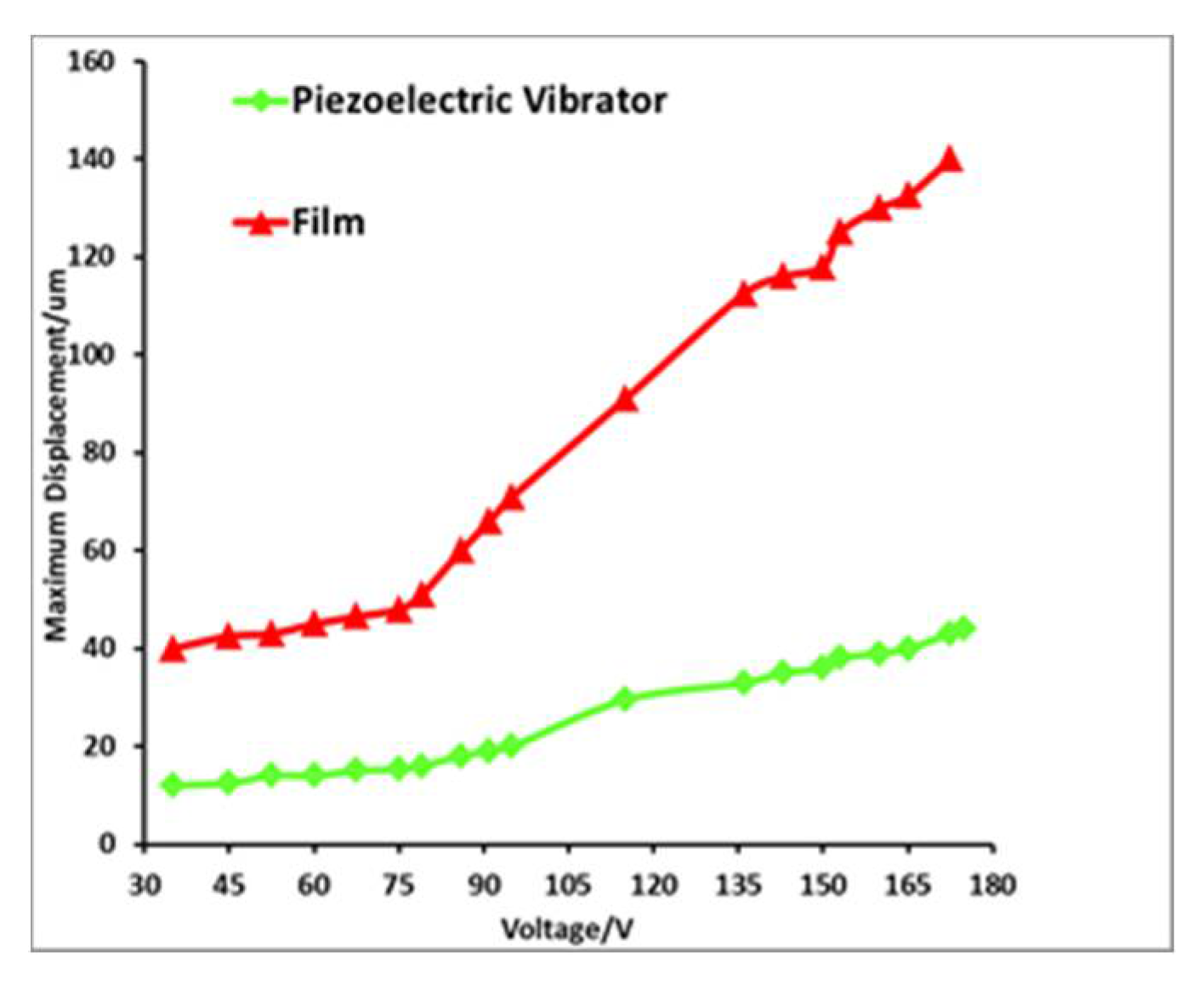
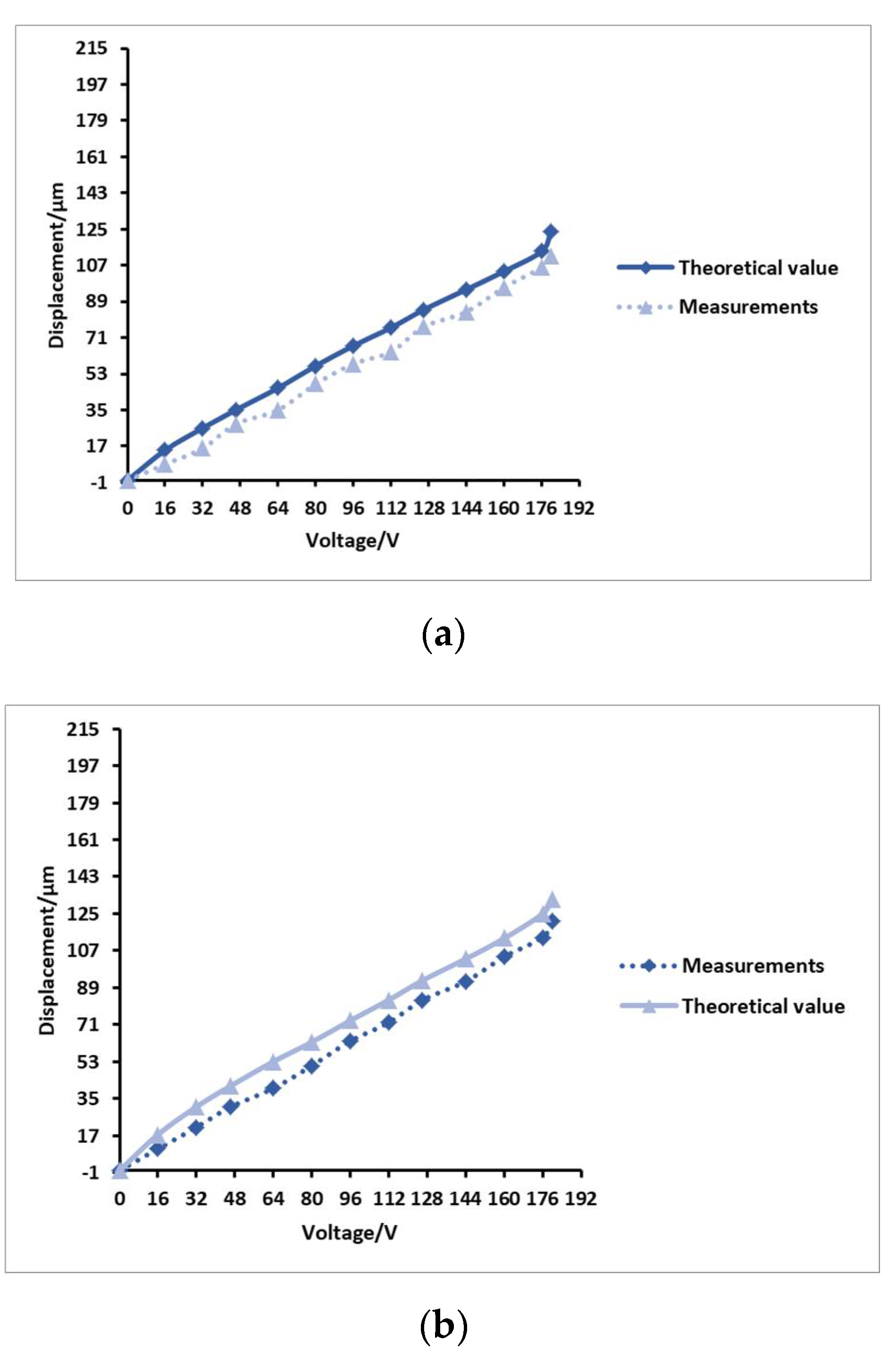
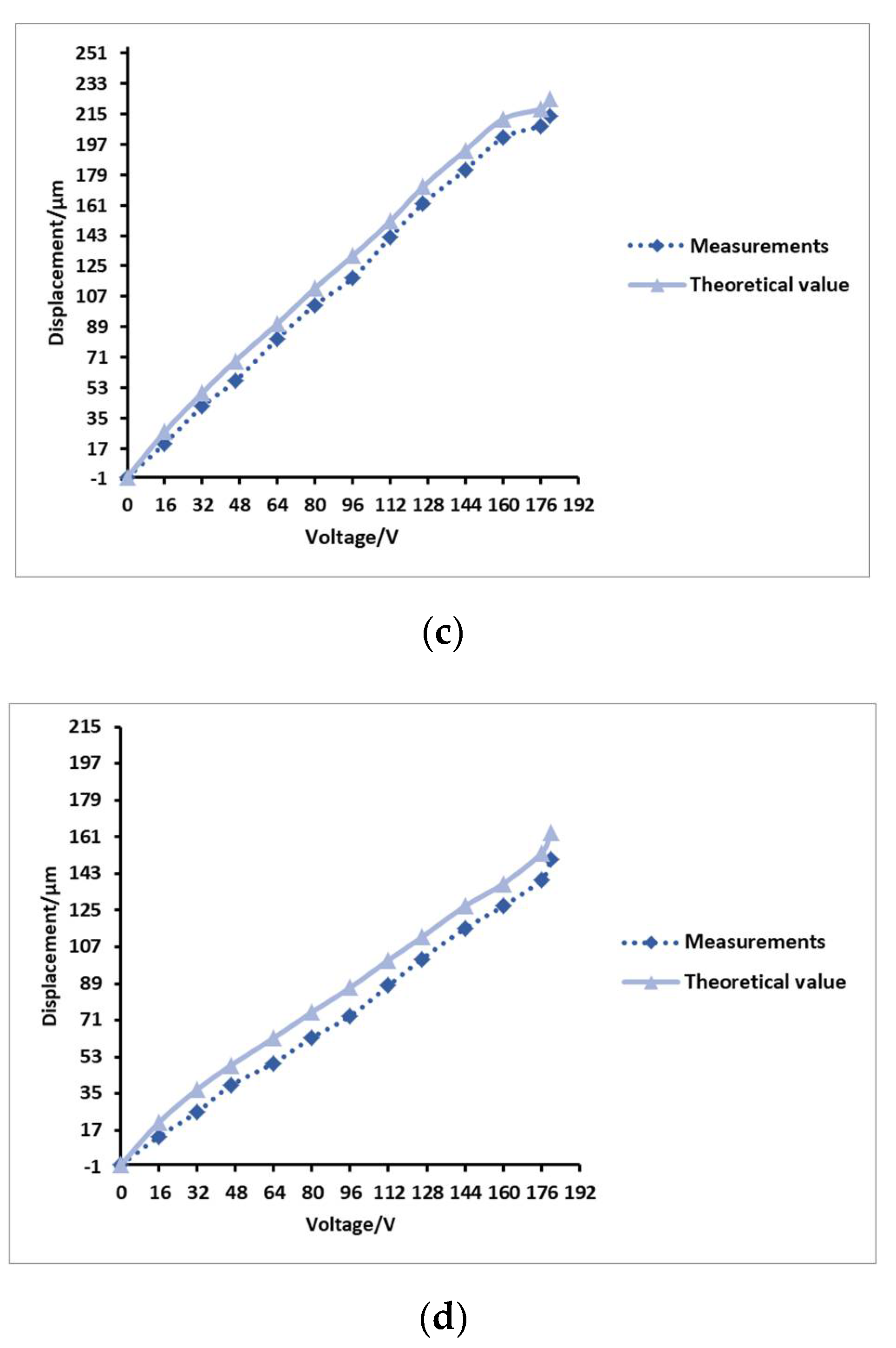
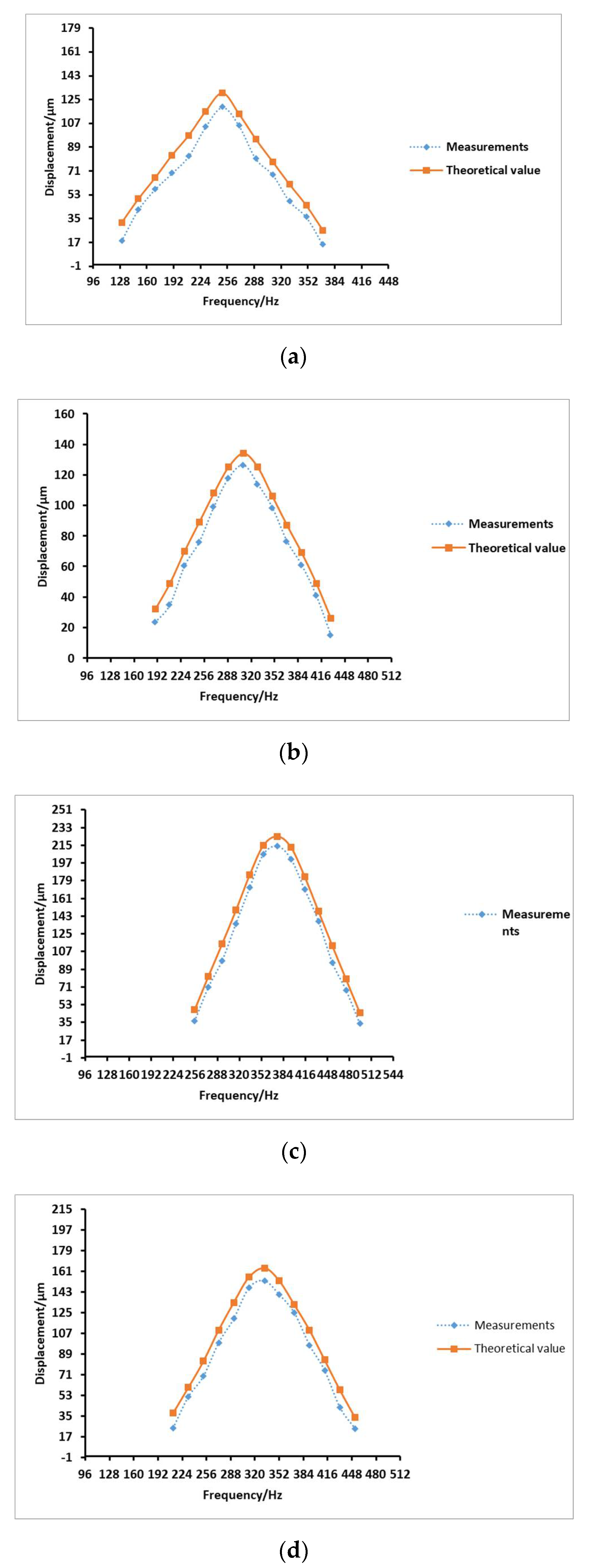
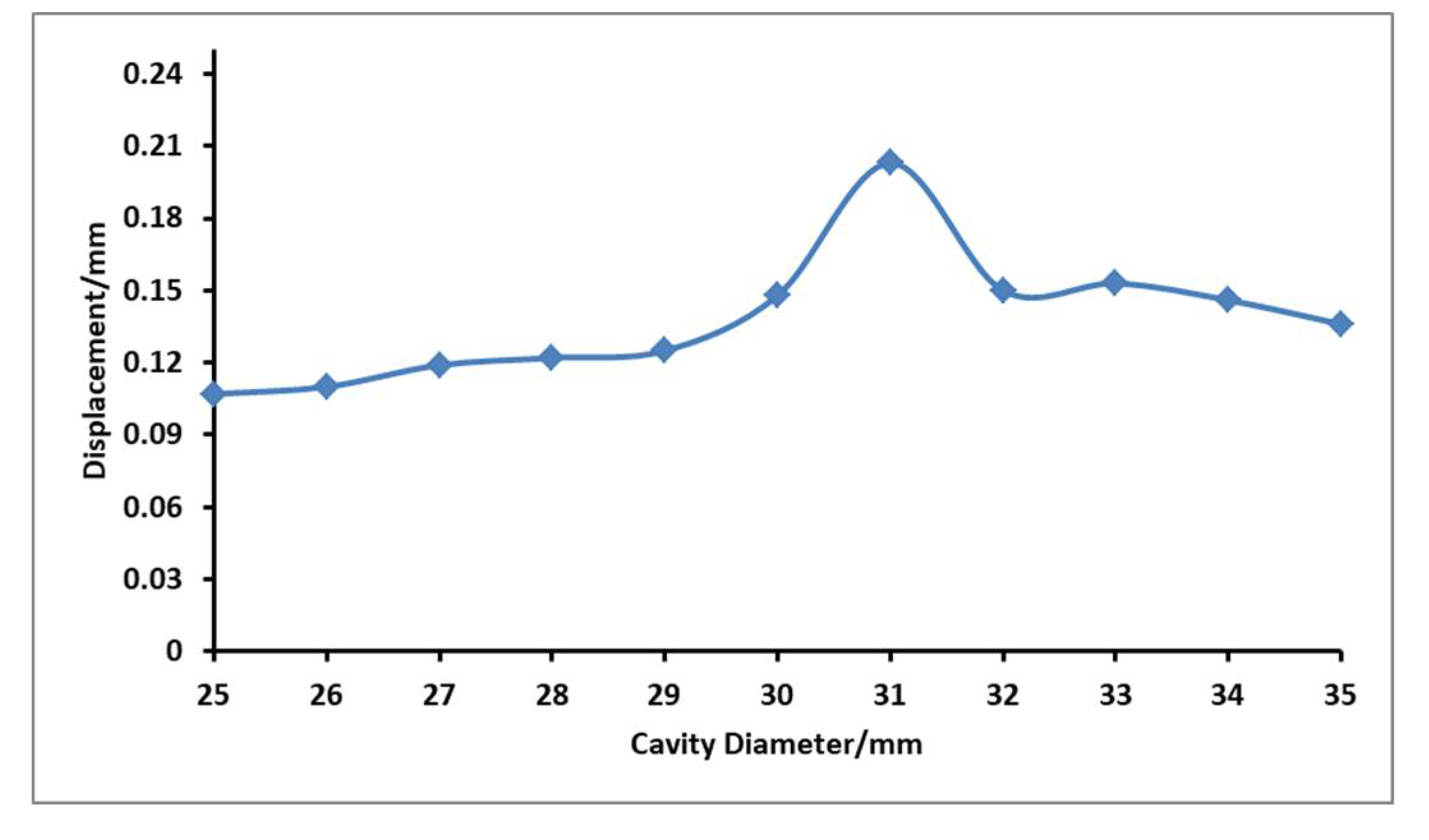
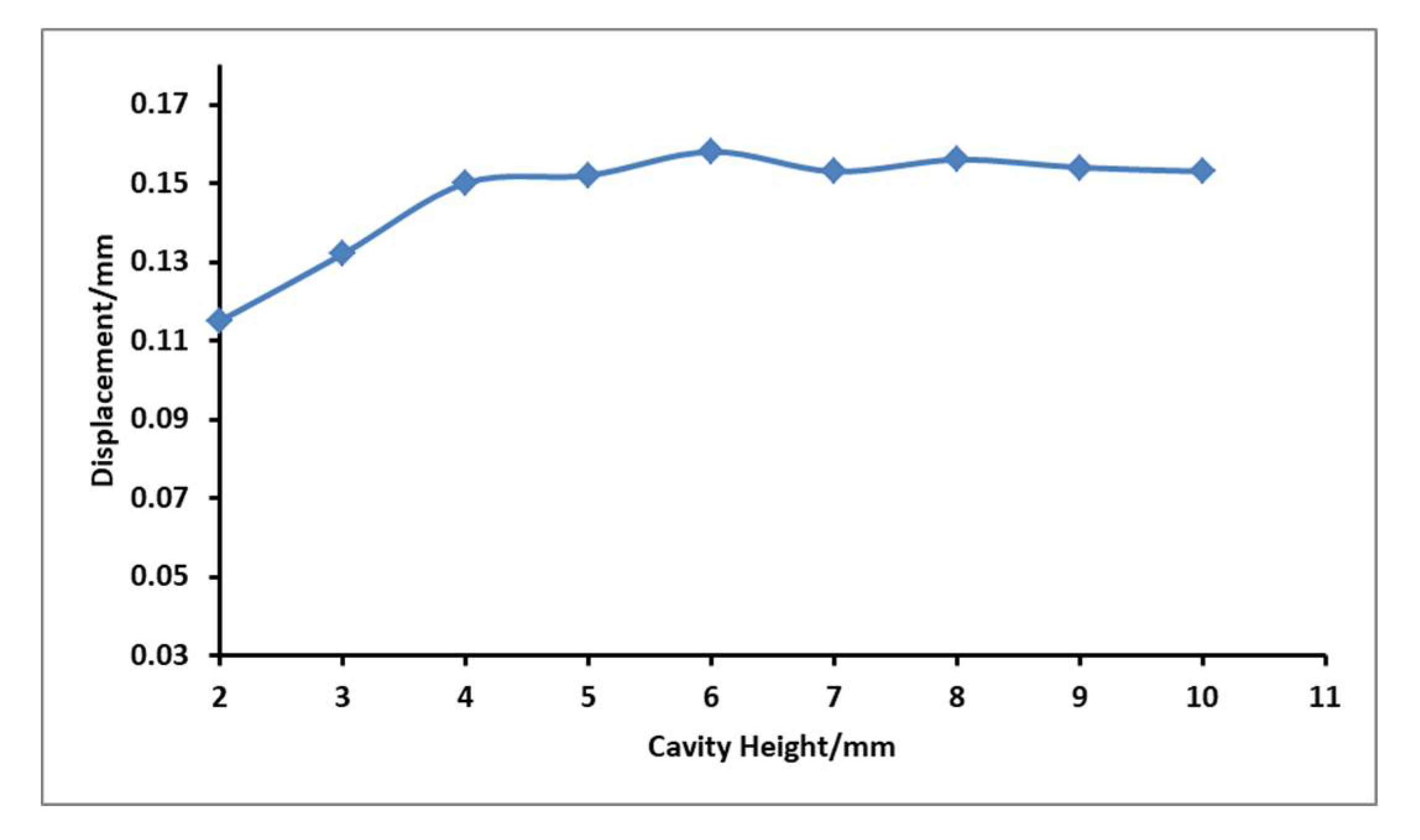
| Material | E /Gpa | R /mm | T /mm | M /g | K N/m | V | F /N | X /μm | C |
|---|---|---|---|---|---|---|---|---|---|
| Flexible Film(a) | 7.84 × 10−3 | 7 | 0.5 | 3 | 111 | 0.47 | 0.58 | 115 | 1 |
| Elastic Sheet(b) | 128 | 13 | 0.4 | 1.5 | 241,597 | 0.35 | 2 | 397 | 0.008 |
| Group r | Fluid Cavity Diameter | Fluid Cavity Height | Water Filling |
|---|---|---|---|
| First | 27 mm | 4 mm | 7.5 mL |
| Second | 29 mm | 5 mm | 8.2 mL |
| Third | 31 mm | 6 mm | 8.8 mL |
| Fourth | 32 mm | 7 mm | 9.3 mL |
Publisher’s Note: MDPI stays neutral with regard to jurisdictional claims in published maps and institutional affiliations. |
© 2021 by the authors. Licensee MDPI, Basel, Switzerland. This article is an open access article distributed under the terms and conditions of the Creative Commons Attribution (CC BY) license (https://creativecommons.org/licenses/by/4.0/).
Share and Cite
Tian, X.; Sun, Y.; Li, Z.; Wang, H.; Wang, Z.; Wang, H.; Zhu, J.; Yang, Z. Design and Experiment Using Flexible Bumps for Piezoelectric-Driven Hydraulically Amplified Braille Dot Display. Micromachines 2021, 12, 795. https://doi.org/10.3390/mi12070795
Tian X, Sun Y, Li Z, Wang H, Wang Z, Wang H, Zhu J, Yang Z. Design and Experiment Using Flexible Bumps for Piezoelectric-Driven Hydraulically Amplified Braille Dot Display. Micromachines. 2021; 12(7):795. https://doi.org/10.3390/mi12070795
Chicago/Turabian StyleTian, Xiaochao, Yuze Sun, Zhiyao Li, Hu Wang, Zhicong Wang, Haigang Wang, Jinzhi Zhu, and Zhigang Yang. 2021. "Design and Experiment Using Flexible Bumps for Piezoelectric-Driven Hydraulically Amplified Braille Dot Display" Micromachines 12, no. 7: 795. https://doi.org/10.3390/mi12070795
APA StyleTian, X., Sun, Y., Li, Z., Wang, H., Wang, Z., Wang, H., Zhu, J., & Yang, Z. (2021). Design and Experiment Using Flexible Bumps for Piezoelectric-Driven Hydraulically Amplified Braille Dot Display. Micromachines, 12(7), 795. https://doi.org/10.3390/mi12070795











